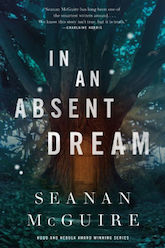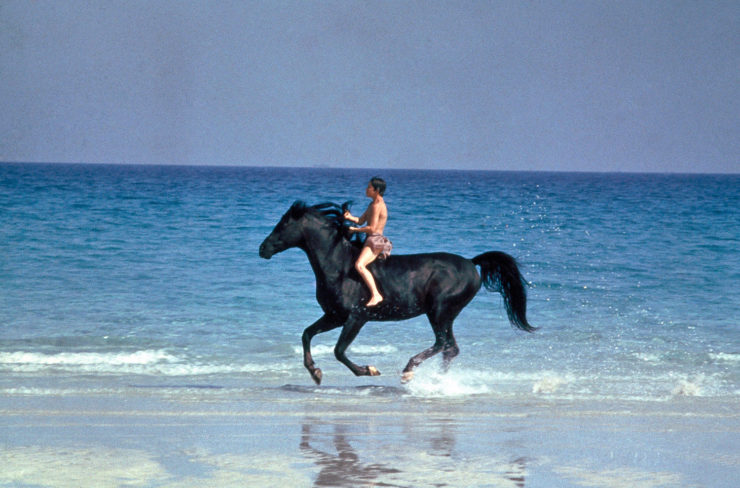Whenever the conversation turns toward horse movies, one of the first mentioned is always The Black Stallion. Everybody knows this one, and just about everybody loves it. It’s an icon.
Even horse people include it in their Best Of lists. Next to The Man From Snowy River, it’s an all time favorite. Many a horsekid imprinted on Arabians, and especially black Arabian stallions, because of this film.
It’s based on a book that’s just as beloved a classic, Walter Farley’s The Black Stallion. But it’s very much its own thing.
I was never a huge fan of it, though I acknowledged that it’s very pretty. The horse star, Cass Ole, is lovely, and Kelly Reno does an excellent job playing the seriously aged-down Alec. I have a low tolerance for Auteur Pretensions, and what felt like endless hours of swoopy music and dreamlike sequences on that beach made me wish he would just get on with it already.
But I’m a lousy spectator anyway. I’d far rather ride a horse than watch one being ridden. So I accept that I have this flaw in my character.
Rewatching it for SFF Equines was an interesting experience. All the rereading and film-watching I’ve been doing lately has given me a much larger immediate context, and since I saw it in the theater in 1979, closed captioning has become a thing. Not that it matters much at all in the first half of the film, since so much of it is without dialogue and the rest is mostly self-evident, but those extra bits of context do help.
What I hadn’t remembered from the last time I watched it somewhere back along on cable TV was how truly surreal the whole film is. I had it labeled in my head as “Beginning boooooring, end not so bad,” but the boring part is kind of eerily amazing if you watch it in the right frame of mind. Curled up on the couch on a very windy, chilly day, in between runs out to the barn to check on horses (wind chill is not a lot of fun for my very aged seniors, and let’s not even talk about the exploding shelter, the flapping blankets, the broken back door…), turned out to be just about perfect. I had completely forgotten the opening sequence on the ship, which has a distinct flavor of Raiders of the Lost Ark—two years before the latter film was released. It’s the image of the late Forties as dimly lit, smoky, and just barely legal, with unsubtle racist undertones, and groups of unsavory people gambling for high stakes in unusual settings.
Part of the loot that Alec’s dad wins is a clearly labeled and spotlighted Symbol, a stylized version of an ancient Greek votive horse. This comes complete with dad telling wide-eyed young Alec the story of his namesake Alexander and the wild back horse Bucephalus (or Boukephalas in the transliterated Greek) whom the king wanted to kill, but Alexander rode him and saved him and received him as a gift. (And continued to ride all across Asia, till he died at a grand age, about the same as my younger senior mare now I think of it, and was mourned with massive pomp, but that’s my geekery showing; the story never gets that far in the movie.)
Buy the Book


In An Absent Dream
Alec has a real-life horse to attach to the story: a furious stallion locked in the hold and guarded by a slimy Arab, who threatens Alec when he slips lumps of sugar to the horse through the tiny window of his shipping compartment. Then later, when the ship blows up and sinks, the slimy Arab mugs Alec and steals his life vest. Speaking of unsubtle racism.
And then the ship sinks and the horse tows Alec to a deserted beach, and we’re in for hours and hours and endless hours of dreamlike swimming, rock-clambering, fire-starting, and horse-bonding. With symbolic horse figurine nicely lined up in frame with the real horse who looks just like it.
The cinematography really is beautiful. Gorgeous. Breathtaking.
But man, as a horse person, I have questions.
Alec wakes up alone in the surf. In his pajamas. With handy pocket knife (more of the Significant Dad Loot) and horse figurine. It takes at least a day for him to sort himself out, and when he does, he finally finds the horse, tangled up in lines and spars, thrashing in the wet sand.
Which is very pretty and Alec saves him with handy pocket knife and yay, but man, if he’s been there for hours, he’s dead. He’s either broken a leg or his neck in his struggles or colicked fatally from stress or dehydration. And even supposing he’s a superhorse of iron constitution (as the vet at the end says about his leg) and he’s lasted this long without serious damage, there’s still the question of where he’s finding enough water to keep him going after he’s free, and what he’s eating, because they’re apparently there for weeks and he’s literally living on air.
Alec’s shell platter of wilted greens emphatically does not count. Horse stomachs are not made to deal with anything that’s “off” or fermented. One of the worst things you can feed them is lawn clippings, because once they start to wilt, they go toxic-to-horses. (Hay is a different proposition: it’s dried and cured before baling. Hay baled wet has similar problems to lawn clippings; mold and fermentation are bad, bad things for horses.) Alec has killed the horse.
Which is how I know the Auteur is not a horse person. He loves the aesthetics but he isn’t into the practical. A horse person would give the Black a hidden valley with enough grass and water to keep him going. Alec would bribe him with fresh grass.
It’s kind of amusing to see this horse, who is supposedly living on next to nothing, played by a glossy animal who is obviously very well fed. Cass Ole is extremely round and fat and sleek. He does get a few token tangles in that glorious mane, which is a good touch, but all that mane in the real world would be a hopeless mess of dreads and elflocks. Alec could keep himself occupied for days working out all the knots. And he’d be running back and forth endlessly with that shell, carrying water, unless the Black had found a spring (and grass or usable forage).
Once they’re off the island and into the suburban U.S., the action speeds up considerably, but the dreamlike tone persists. The Black shows up in the Ramsays’ backyard, to the great surprise of the neighbors, but he quickly escapes to a more suitable rural environment and the next phase of the story, with crusty old trainer Henry and his two weird friends like avatars of the Fates, and the old white horse Napoleon (who appears to be played by either another Arabian or an Andalusian—definitely not your basic street horse—and then there’s the symbolic significance of the white horse as spirit guide, which adds to the ambience).
The match race nicely takes care of the problem with racing “the fastest horse in the world” against more conventional racehorses. Here is a whole world of Arabian racing, but that’s not mentioned. The racehorses in the film are Thoroughbreds, and that means, apart from individual challenges like the one the Black party-crashes, no horse can enter a race without Jockey Club papers. Definitely no horse who is obviously not a Thoroughbred, papers or not.
The race being two miles long is a little bit wicked, because Thoroughbreds in general are milers. The longest Triple Crown race is a mile and a half, and that’s considered lengthy. Adding another half-mile puts it into longer distance territory, and that’s where the Arabian begins to claim his place.
The Arabian is the premier marathon runner of the horse world. Endurance races are dominated by Arabians. Twenty-five, fifty, a hundred miles—you want that legendary stamina and that slow burn of speed. The Quarter Horse is the sprinter, with his blazing speed over a quarter-mile, but he poops out quickly. The Thoroughbred is the champion of the mile and a bit, and he’s pretty damn good at steeplechases and eventing courses, too. But when the Thoroughbred is running out of steam, the Arabian has just barely started to run.
It’s a great movie race, with bonus stallion fight and nasty injury to the Black—who flat refuses to let Alec turn him around or stop him (good horseman, that kid is) and who runs his heart out from far behind and takes the race. Hence the comment which I sincerely appreciate, with the vet wrapping up the leg and declaring it’s made of iron. Somebody cared to include that scene, for all the horse people who would worry.
In the end, as I watched the credits roll, I realized that this is another great fantasy film disguised as a “realistic” story. It’s all about the dream of bonding with the wild horse, the beautiful black stallion who carries the helpless rider off wherever he pleases: the pooka, the kelpie, the creature of the Otherworld who comes into ours in order to capture a human. But the human meets him halfway and captures him just as securely.
When Alec is carried off from the island, protesting mightily at leaving the horse behind, the the Black makes a visibly difficult choice and follows. Their long, long sequence on the beach is about the bond, the love between horse and his chosen person. They tame each other. They dance together. The human learns to ride from the horse (with many falls and stumbles), until finally they fly together. And that’s how the match race ends: Alec drops the reins, spreads his arms, and lets the horse carry him, flying free.
It’s every horsekid’s fantasy. She knows the connection between horse and human, combining two separate minds and bodies into a single powerful being. She’s felt the wind of his speed in her face. She knows what it’s like to fly.
Judith Tarr is a lifelong horse person. She supports her habit by writing works of fantasy and science fiction as well as historical novels, many of which have been published as ebooks by Book View Cafe. She’s even written a primer for writers who want to write about horses: Writing Horses: The Fine Art of Getting It Right. Her most recent short novel, Dragons in the Earth, features a herd of magical horses, and her space opera, Forgotten Suns, features both terrestrial horses and an alien horselike species (and space whales!). She lives near Tucson, Arizona with a herd of Lipizzans, a clowder of cats, and a blue-eyed dog.










